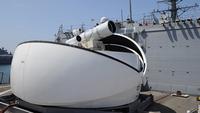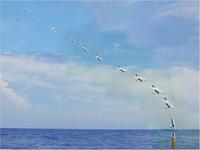-
Ray gunsA first: U.S. Navy shipboard laser operates in Persian Gulf

The U.S. Navy announced that a laser weapon system (LaWS) — a cutting-edge weapon that brings significant new capabilities to America’s Sailors and Marines — was for the first time successfully deployed and operated aboard a naval vessel in the Persian Gulf. The operational demonstrations, which took place from September to November aboard USS Ponce (AFSB[I] 15), were historic not only because they showed a laser weapon working aboard a deployed U.S. Navy ship, but also because LaWS operated seamlessly with existing ship defense systems. During the tests, LaWS hit targets mounted aboard a speeding oncoming small boat, shot a Scan Eagle unmanned aerial vehicle (UAV) out of the sky, and destroyed other moving targets at sea.
-
-
AmmoLead ammunition should be replaced by steel in shooting sports: experts
Researchers say that Olympic athletes specializing in shooting use one thousand cartridges per week and scatter some 1.3 tons of lead yearly, with harmful effects for surrounding animals and agricultural land. The researchers urge the International Olympic Committee and other sports organizations to replace lead ammunition with steel, which is non-toxic and contains similar technical characteristics.
-
-
In the trenchesU.S. Navy demonstrates UAV launch from submerged submarine

The U.S. Naval Research Laboratory (NRL) demonstrated the launch of an all-electric, fuel cell-powered, unmanned aerial system (UAS) from a submerged submarine. The successful submerged launch of a remotely deployed UAS offers a pathway to providing mission critical intelligence, surveillance, and reconnaissance (ISR) capabilities to the U.S. Navy’s submarine force.
-
-
Iran agreementUranium, plutonium, heavy water … why Iran’s nuclear deal matters
The agreement reached with Iran will limit enrichment to 5 percent U-235 and allow International Atomic Energy Agency (IAEA) inspectors regular visits (even daily) to their facilities. The inspectors can easily determine the ratios of U-235 and Pu-239 in the input fuel and waste streams via the characteristic radiation signatures of the isotopes involved. These stand out like a sore thumb to their instruments. In addition, the IAEA will measure the amount of U-235 employed at each facility to determine if any of the uranium is diverted to undisclosed locations. While this arrangement is operating it is highly unlikely that Iran will be able to build nuclear weapons.
-
-
Nuclear mattersScientific explanation overturned -- good news for nuclear fusion
A team of Duke University researchers has discovered, much to its surprise, that a long-accepted explanation of how nuclei collide to produce charged particles for electricity — a process receiving intense interest lately from scientists, entrepreneurs, and policy makers in the wake of Japan’s nuclear crisis — is flat out wrong; the discovery of the error makes nuclear reactors based on fusion more realistic
-
-
Engineers to enhance crane-mounted cargo scanning system
VeriTainer, a venture-backed specialist in crane-based radiation detection technology for scanning shipping containers, enters into a three-and-a-half years, $4 million n R&D agreement with Lawrence Livermore National Laboratory to enhance the gamma and neutron detection sensitivity of the company’s radiation scanners
-
- All
- Regional
- Water
- Biometrics
- Borders/Immig
- Business
- Cybersecurity
- Detection
- Disasters
- Government
- Infrastructure
- International
- Public health
- Public Safety
- Communication interoperabillity
- Emergency services
- Emergency medical services
- Fire
- First response
- IEDs
- Law Enforcement
- Law Enforcement Technology
- Military technology
- Nonlethal weapons
- Nuclear weapons
- Personal protection equipment
- Police
- Notification /alert systems
- Situational awareness
- Weapons systems
- Sci-Tech
- Sector Reports
- Surveillance
- Transportation
Advertising & Marketing: advertise@newswirepubs.com
Editorial: editor@newswirepubs.com
General: info@newswirepubs.com
2010-2011 © News Wire Publications, LLC News Wire Publications, LLC
220 Old Country Road | Suite 200 | Mineola | New York | 11501
Permissions and Policies
Editorial: editor@newswirepubs.com
General: info@newswirepubs.com
2010-2011 © News Wire Publications, LLC News Wire Publications, LLC
220 Old Country Road | Suite 200 | Mineola | New York | 11501
Permissions and Policies
